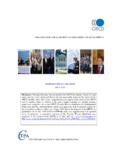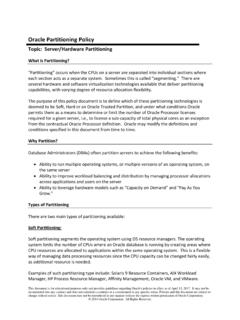Transcription of Shifting the carbon pricing debate - EY
1 Shifting the carbon pricing debate Emerging business attitudes fuel momentum for global climate action Shifting the carbon pricing debate I 1. Welcome from EY. Conversations about the role of business in finding solutions to climate change have increased in both their sophistication and specificity in recent years. A growing number of businesses are now actively investing in low- carbon initiatives and technologies. Such moves are proving to be of benefit not only to the environment, but to a business's bottom line. In the context of this year's COP21 gathering in Paris, low- carbon discussions are gaining momentum.
2 Since agreements in Kyoto and Durban, and in anticipation of Paris, the paths to a large-scale reduction in greenhouse gas emissions from businesses are becoming global considerations. As those discussions widen, the interest in harmonized, reliable and transparent methods for carbon pricing is likely to intensify. In an effort to better understand the drivers for business, and in the context of EY's participation in the World Bank's carbon pricing Leadership Coalition, we commissioned this survey to take a pulse on the issue and practice of carbon pricing . For some time, the thinking was that any carbon pricing protocol would require outside direction for businesses to act.
3 The deployment of carbon pricing mechanisms has met resistance due to concerns regarding their potential effect on business competitiveness. Now, our survey findings along with growing business support for a number of key initiatives driven by the likes of the United Nations (Business Leadership Criteria), the World Bank and the World Business Council for Sustainable Development (WBCSD) . provide evidence that companies are increasingly open to taking independent carbon pricing action, fully expecting it will actually improve overall performance. Such action will be complicated and our survey suggests uneven but it will bring a wealth of opportunity from which proactive businesses may benefit.
4 Companies that intend to lead are already incorporating future expected carbon prices required for innovative and expensive technology into their decision-making. Businesses, generally, need to understand these market-driven solutions. Advancements, such as those expected from COP21, will only serve to further motivate the private sector. We appreciate the participation of the executives in our survey, and we hope this discussion helps spotlight how the adoption of carbon pricing by business may be driving global climate action. Juan Costa Climent Global Leader of Climate Change and Sustainability Services EY +34 915 727 381.
5 2 I Shifting the carbon pricing debate Introduction Surrounding this year's 21st Conference of the Parties to the United Nations Framework Convention on Climate Change (COP21), increasing numbers of multinational businesses and global institutions have come out in support of carbon pricing . This report, commissioned by EY's Climate Change and Sustainability Services practice, highlights the findings from a survey exploring the prevailing views of businesses around the world toward carbon pricing , as both a regulatory necessity and strategic corporate priority. It finds not only that carbon pricing is welcomed by the majority of respondents as the best way to cut carbon emissions, but that it is also expected to bring benefits to companies in a number of areas.
6 On 1 June 2015, six major oil companies wrote an open letter saying that they would be able to take faster action on climate change if there was a stronger eventually global carbon pricing framework in This is a sharp change from a decade ago, when energy sector companies were more commonly raising doubts about the urgency of climate change rather than actively supporting strategies to reduce carbon emissions. What's driven this? There is a growing likelihood that we will see some price on carbon established, explains Mathew Nelson, Deputy Global Leader of EY's Climate Change and Sustainability Services practice.
7 The conversation is gradually changing from if and when' carbon pricing will happen to how' it will happen.. More than 430 companies around the world have already set internal prices for their carbon emissions. In 2014, the number of companies setting an internal price for carbon stood at just 150. Another 583 companies say they will adopt carbon pricing in the next two carbon pricing is widely accepted today as one of the most effective tools to reduce greenhouse gas emissions, says Lila Karbassi, Head of Environment and Climate at the UN Global Compact. We see a lot of signals from businesses across regions and sectors that using a price on carbon is an effective means to reducing emissions.
8 Through our Business Leadership Criteria on carbon pricing ,3 nearly 60 companies have committed to setting, advocating and reporting a meaningful price on carbon . This is confirmed by the respondents to our survey, 54% of whom believe carbon pricing is the most effective way to cut carbon emissions. Although carbon - pricing frameworks such as the European Emissions Trading System (EU ETS) and national carbon taxes are already a fact of life for some companies, a growing number are taking voluntary steps to implement an internal price for carbon in anticipation of such regulations in their operating markets.
9 In time for the COP21 meeting in December 2015, EY conducted this new study, surveying more than 100 executives from around the world that have an impact on their company strategies. The following are the key findings that highlight their attitudes to carbon pricing . We see a lot of signals from businesses across regions and sectors that using a price on carbon is an effective means to reducing emissions. 1 Six Oil Majors Say: We Will Act Faster with Stronger carbon pricing ,' UNFCCC, June 1, 2015 newsroom/major-oil-companies-letter-to-u n/. 2 Threefold surge in companies disclosing carbon price shows climate change concerns going mainstream,' CDP, September 21, 2015.
10 3 See the Caring for Climate Business Leadership Criteria on carbon pricing : . Shifting the carbon pricing debate I 3. Prevailing business attitudes toward carbon pricing carbon pricing a growing business consensus Our survey found that more than half of respondents (54%) believe that carbon pricing is the most effective way to cut carbon emissions. Nearly half (48%) say their company is in favor of carbon pricing , with only 7% of companies opposing (see Figure 1). While in Europe and emerging markets, the majority of companies in our survey consider themselves to be in favor of carbon pricing (at 64% and 59%, respectively), in the US, companies were much more likely to be neutral on the topic, with only 18% overtly in favor of carbon pricing (see Figure 2).
















